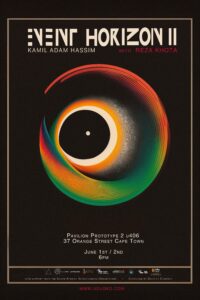
Event Horizon II
Cape Town, Western Cape 8000 South Africa
Event Horizon II with Kamil Adam Hassim and Reza Khota

‘Event Horizon II’, Kamil Hassim’s latest exhibition with — defunct context. In this exhibition, Kamil takes us on a journey through the mysteries of black holes and the cosmic principles that govern our universe. At the heart of his work lies an exploration of how information permeates through social, cultural, and physical systems based on notions of the event horizon, the information paradox, and the holographic principle.
This exhibition is the result of Kamil’s residency at CERN, SAAO Astronomy, and SARAO, and his artistic research into fundamental physics, modern African astronomy, and ancient indigenous cosmologies. Presented in collaboration with —defunct context, and the support of the South African Astronomical Observatory, Iziko Museums, and curated by Sihle Sogaula, ‘Event Horizon II’ is a unique and thought-provoking exploration of the intersection between art, science, and indigenous knowledge systems.
The event horizon is the boundary around a black hole beyond which nothing can escape. It is a point of no return, where the gravitational pull is so strong that even light cannot escape. The information paradox refers to the problem of what happens to information that falls into a black hole. According to the laws of physics, information cannot be destroyed, yet it seems to disappear when it falls into a black hole. The holographic principle suggests that all the information contained within a region of space can be represented on the boundary of that region, much like a hologram.
The idea of embodied knowledge is central to many indigenous knowledge systems, which hold that knowledge is not something that can be acquired solely through intellectual pursuits. Rather, it is something that must be felt and experienced, in order to be fully understood. Kamil’s work seeks to bridge the gap between science and indigenous knowledge systems, by inviting us to explore the mysteries of the universe in a way that is grounded in our own bodies and experiences.
Kamil’s work invites us to contemplate these complex ideas through our senses and emotions, rather than just through our intellect. By using astronomical defunct lenses to create optical effects, his installations immerse us in an experience that is designed to facilitate a process of “embodied knowledge”. This process allows us to engage with these ideas on a visceral level, connecting us more deeply to the mysteries of the cosmos.
The holographic principle, which suggests that all the information contained within a region of space can be encoded on its boundary, is another example of how information can be lost or obscured within a closed system. This principle implies that the universe may be like a hologram, with three-dimensional information projected onto a two-dimensional surface.
In the context of cultural systems and the effects of colonialism, the erasure of knowledge and the loss of information can be seen as similar processes. The imposition of colonialism often involved the suppression of indigenous knowledge systems and the imposition of Western epistemologies. This has resulted in the loss of knowledge and cultural heritage for many communities around the world.
The intersection of art and science, as explored in the ‘Event Horizon II’ exhibition, offers a way to bridge these gaps and connect people to the mysteries of the cosmos while also acknowledging the importance of different cultural knowledge systems. The exhibition seeks to create an immersive experience that allows visitors to develop embodied knowledge of phenomena like light and data, while also engaging with the complex cultural and scientific concepts associated with black holes. By doing so, it offers a space for dialogue and engagement that can help to promote a more inclusive and diverse understanding of science and its relationship to culture.
- There were no results found.

